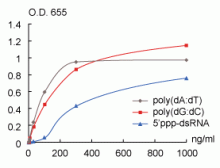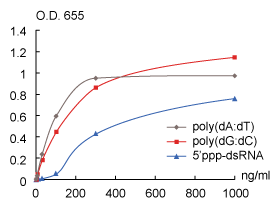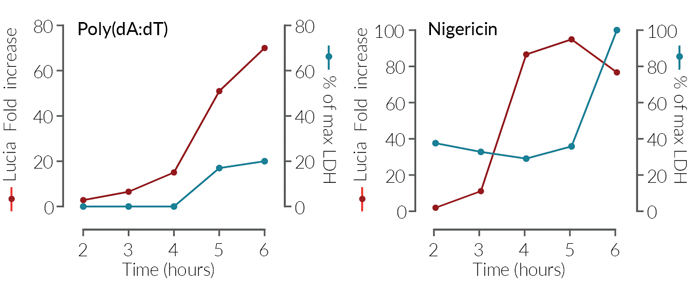Poly(dA:dT)
| Product | Unit size | Cat. code | Docs. | Qty. | Price | |
|---|---|---|---|---|---|---|
|
Poly(dA:dT) naked dsDNA naked |
Show product |
200 µg 1 mg |
tlrl-patn
|
|
||
|
Poly(dA:dT) / LyoVec™ dsDNA naked - complexed with transfection reagent |
Show product |
100 µg |
tlrl-patc
|
|
Synthetic analog of B-DNA
Poly(dA:dT) is a poly(deoxyadenylic-deoxythymidylic) acid sodium salt. It is a repetitive synthetic double-stranded DNA sequence of poly(dA-dT):poly(dT-dA) and a synthetic analog of B-DNA.
Poly(dA:dT) is recognized by multiple PRRs:
- Sensing by cytosolic DNA sensors (CDS), including cGAS, AIM2, DAI, DDX41, IFI16, and LRRFIP1, triggers the production of type I interferons [1-3].
- Sensing by the cytosolic DNA sensor AIM2 triggers the formation of an inflammasome and the subsequent secretion of IL-1β and IL-18 [4].
- Indirect sensing by the cytosolic RNA sensor RIG-I can occur upon the transcription of Poly(dA:dT) into dsRNA with a 5'triphosphate moiety (5'ppp-dsRNA) by the RNA polymerase III [5,6]. This indirect sensing by RIG-I leads to the production of type I interferons [7].
To achieve stimulation of cytosolic PRRs, Poly(dA:dT) must be delivered into the cytoplasm, for example by using a transfection agent, such as LyoVec™.
Key features:
- Multi-PRR agonist
- For your convenience, pre-complexed Poly(dA:dT)/ LyoVec™ is also available.
- Each lot is functionally tested
References:
1. Unterholzner L., 2013. The interferon response to intracellular DNA: why so many receptors? Immunobiology. 218(11):1312-21.
2. Zhang Z. et al., 2011. The helicase DDX41 senses intracellular DNA mediated by the adaptor STING in dendritic cells. Nat Immunol. 12(10):959-65.
3. Wu J. et al., 2013. Cyclic GMP-AMP is an endogenous second messenger in innate immune signaling by cytosolic DNA. Science. 339(6121):826-30.
4. Jones JW. et al., 2010. Absent in melanoma 2 is required for innate immune recognition of Francisella tularensis. PNAS, 107(21):9771-6.
5. Ablasser A. et al., 2009. RIG-I-dependent sensing of poly(dA:dT) through the induction of an RNA polymerase III-transcribed RNA intermediate. Nat Immunol. 10(10):1065-72.
6. Chiu YH. et al., 2009. RNA polymerase III detects cytosolic DNA and induces type I interferons through the RIG-I pathway. Cell. 138(3):576-91.
7. Takeshita F. & Ishii KJ., 2008. Intracellular DNA sensors in immunity. Curr Opin Immunol. 20(4):383-8.
Specifications
Specificity: RIG-I & CDS agonist, AIM2 inflammasome inducer
Formulation: Naked or pre-complexed with LyoVec™
CAS number: 86828-69-5 (for Naked Poly(dA:dT))
Working Concentrations:
- 10 ng- 1 μg/ml for Naked Poly(dA:dT) for CDS or RLR stimulation.
- 1 µg- 5 μg/ml for Naked Poly(dA:dT) for inflammasome induction.
- 10 ng- 10 μg/ml for pre-complexed Poly(dA:dT)/LyoVec™ for CDS or RLR stimulation.
- 1 µg- 5 μg/ml for pre-complexed Poly(dA:dT)/LyoVec™ for inflammasome induction.
Solubility:
- 2 mg/ml in water for Naked Poly(dA:dT)
- 50 µg/ml in water for pre-complexed Poly(dA:dT)/LyoVec™
Quality Control:
- The biological activity has been verified using cellular assays.
- The absence of bacterial contamination (lipoproteins and endotoxins) has been confirmed using HEK-Blue™ TLR2 and HEK-Blue™ TLR4 cells.
Contents
Poly(dA:dT) Naked is available in two quantities:
tlrl-patn:
- 200 µg lyophilised poly(dA:dT) naked
- 1.5 ml sterile endotoxin-free water
tlrl-patn-1:
- 1 mg lyophilised poly(dA:dT) naked
- 1.5 ml sterile endotoxin-free water
Poly(dA:dT)/LyoVec™ is available in one quantity:
tlrl-patc:
- 4 x (25 µg Poly(dA:dT) complexed with 50 µg of LyoVec™), lyophilized
- 10 ml sterile endotoxin-free water
![]() Poly(dA:dT) and Poly(dA:dT)/LyoVec™ are provided lyophilized and shipped at room temperature.
Poly(dA:dT) and Poly(dA:dT)/LyoVec™ are provided lyophilized and shipped at room temperature.
![]() Store lyophilized Poly(dA:dT) and Poly(dA:dT)/LyoVec™ at -20°C.
Store lyophilized Poly(dA:dT) and Poly(dA:dT)/LyoVec™ at -20°C.
![]() Lyophilized product is stable for 1 year when stored -20°C.
Lyophilized product is stable for 1 year when stored -20°C.







